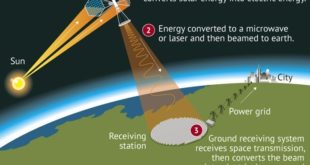Introduction: As the world turns its gaze toward lunar exploration, the Defense Advanced Research Projects Agency (DARPA) is taking bold strides to ensure the development of a robust lunar economy. The Lunar Guidelines for Infrastructure Consortium (LOGIC) emerges as a pivotal initiative, aiming to establish interoperability standards for commercial lunar …
Read More »Revolutionizing the Battlefield: 3D Printing’s On-Demand Arsenal for the Modern Military
Introduction: In the ever-evolving landscape of modern warfare, technology is a key driver of innovation. Among the groundbreaking advancements, 3D printing has emerged as a game-changer, providing the military with unprecedented capabilities. 3D printing or additive manufacturing is ongoing revolution in manufacturing with its potential to fabricate any complex object …
Read More »Harnessing the Cosmos: Space-Based Solar Power Technology Breakthroughs Illuminate a Future of Unlimited Renewable Electricity
Introduction: In the quest for sustainable and efficient energy sources, scientists and engineers have set their sights on the cosmos, unlocking the potential of Space-Based Solar Power (SBSP or SSP). Recent breakthroughs in this revolutionary technology are paving the way for a new era in renewable energy, promising unlimited, clean …
Read More »Navigating Turbulence: The European Economic Security Strategy Amid Geopolitical Tensions
In the dynamic landscape of international relations, Europe finds itself at a crossroads, grappling with rising geopolitical tensions within the continent and the broader rift between the West and China. Within Europe, the ongoing war in Ukraine and its ripple effects on energy markets and supply chains have cast a …
Read More »Powering the Battlefield: Exploring the Military Power Technologies and Solutions Market
In the dynamic and evolving arena of modern warfare, military power technologies and solutions play a pivotal role in ensuring operational preparedness, tactical agility, and strategic superiority. From powering sophisticated weaponry to sustaining troops in remote outposts, these technologies form the backbone of modern military operations. Military power solutions are …
Read More »Revolutionizing Wireless Fronthaul in Industrial Environments: Harnessing Terahertz Frequencies
Introduction: The relentless growth of the Internet of Things (IoT) has driven the demand for high-speed, reliable, and low-latency wireless connectivity in indoor industrial environments. Cell-free massive multiple-input multiple-output (CF-mMIMO) networks have emerged as a promising solution to meet these demands, offering enhanced network capacity and coverage. However, CF-mMIMO networks …
Read More »Unlocking the Secrets of Extreme Environments: Exploring Optical Cryostats and Their Versatile Applications
Introduction: In the ever-evolving landscape of scientific research and experimentation, the need for precise control over environmental conditions has become increasingly paramount. In the realm of scientific exploration, we often venture into the unknown, seeking to unravel the mysteries of extreme environments. From the frigid depths of space to the …
Read More »The Nexus of Environmental and Climate Threats: Implications for Global Security, Military Strategies, and Technological Innovations
Introduction: Climate change is no longer an environmental buzzword; it’s a global security imperative demanding immediate attention. As climate change accelerates and environmental challenges intensify, the world is witnessing a shift in the dynamics of geopolitical landscapes, military strategies, and technological innovations. The once-distant threat is rapidly manifesting in tangible …
Read More »Unlocking Quantum Potential: The Boson-Fermion Quantum Engine
Introduction: In the ever-evolving realm of quantum mechanics, scientists are delving into the fascinating world of quantum engines, and one particular innovation is making waves – the Boson-Fermion Quantum Engine. This cutting-edge technology is poised to revolutionize the landscape of quantum computing and energy systems, offering unprecedented capabilities that harness …
Read More »Revolutionizing Disease Diagnosis: The Future of DNA Detection
In the relentless pursuit of better healthcare, scientists and researchers are constantly pushing the boundaries of medical technology, seeking innovative ways to diagnose and treat diseases more effectively. Among the many promising advancements, DNA detection stands out as a transformative force, poised to revolutionize disease diagnosis and usher in a …
Read More » International Defense Security & Technology Your trusted Source for News, Research and Analysis
International Defense Security & Technology Your trusted Source for News, Research and Analysis


